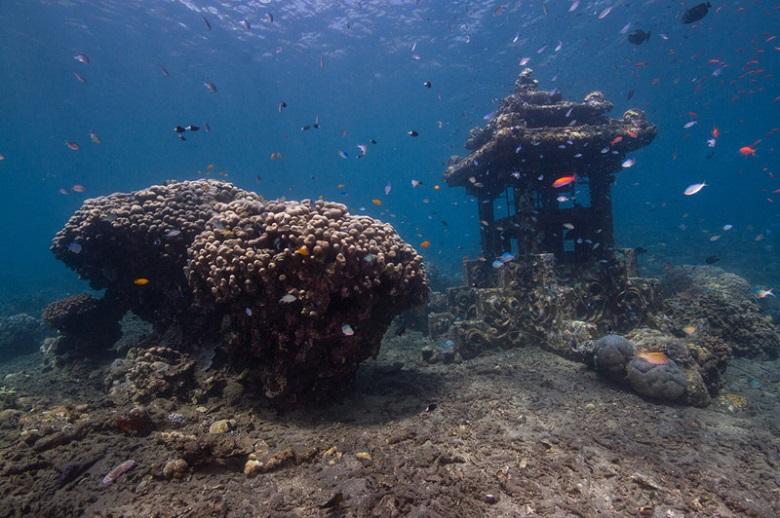In the Chinese province of Zhejiang, about one hundred and fifty kilometers from Hangzhou, there is the beautiful Qiandao Lake or Thousand Island Lake. The secrets behind Shi cheng before the flooding in China
This stunning beauty is by no means a work of the Creator but the work of human hands. Only six decades ago, the valley was flooded to build a hydroelectric power plant. As a result, a little more than a thousand islets were formed, from which the lake got its romantic name. But the most exciting thing in this beautiful place is not what is at the top but what is hidden by the lake’s depths. After all, the Chinese authorities buried two magnificent ancient cities underwater, turning them into a mysterious underwater kingdom.
Qiandao Lake is famous for its crystal clear water. It is used to produce the favorite Nongfu Spring mineral water. The exotic islands are home to beautiful dense forests. This is a popular tourist destination, where each islet has its theme: a monkey island, an island of birds, an island of snakes, an island of castles, and even an island of childhood!
Despite all this, mysterious water depths keep the most exciting things there. Before the appearance of the artificial lake, here at the foot of five lion mountain, there were the two most beautiful ancient cities Shicheng was built over 1300 years ago, in 621 during the Tang Dynasty. Once, it was a mighty city, political, economic, and cultural center.
These ancient cities that preserve the history of a bygone civilization were flooded in September 1959. The Chinese government has decided that there will be a new hydroelectric power station and reservoir. The needs demanded this of the constantly growing population of Hangzhou.
Along with historical values that cannot be assessed, almost thirty more cities, more than a thousand villages, and tens of thousands of hectares of agricultural land were flooded. The authorities resettled just under 300 thousand people, whose families have lived in these places for centuries to implement this project.
The complete indifference of the Chinese government to the preservation of ancient cities is shocking. The submerged history was consigned to oblivion for forty years. Until the local tourism official, Qiu Feng, remembered them, looking for ways to attract tourists to Qiandao Lake. He asked the divers to dive under the water and see what was there.
In September 2001, after trying to get to the flooded city, an official said: “We were lucky. As soon as we dived into the lake, we found the city’s outer wall and even raised a brick.“ Qiu immediately informed the government of his discovery. As many studies were carried out, experts found that the entire city, which had been underwater for several decades, was not damaged at all. Even the wooden beams and stairs have been preserved intact.
After almost ten years of research, in 2011, the ancient cities were finally appreciated as important historical relics. National Geographic magazine printed photographs of the magnificent city and called it “China’s Atlantis.” He looked like a beautiful underwater fairy tale.
It was proposed to open cities to tourists. For this, a unique submarine was built for 48 places for underwater walks. But the government has not decided how the law can regulate the use of a private submarine. In addition, such a device can cause solid underwater currents that can damage ancient buildings. The sub was never meant to be used.
Some experts suggested building a protective wall underwater and pumping water out of the city. But the method was recognized as too time-consuming and expensive. And the walls can not withstand the pressure and collapse. Other experts believe that the best thing right now is to do nothing, as technology is limited.
The authorities are seriously concerned about the preservation of historical sites and began to take measures. “Before using our cultural relics, we must protect them,” said Fang Minghua, former director of the Chun’an County Heritage Management Office. He also noted that currently, the level of technology development does not offer reasonable options.
Researchers and experts are alarmed that those parts of the city that rise from their underwater tomb and are exposed to the air are almost instantly destroyed. Water for these historical values has become the best protection. In addition, the city walls are pretty thin, and there is a genuine danger of damaging them due to water flows.
The authorities propose to ban sailing, fishing, and sand digging on the lake in the surrounding areas to preserve the relic. In the meantime, this place, which bore the proud name “Lion City,” is a kind of diving mecca. Archaeologists are also very interested in preserving this stunning city with such a rich and ancient history.
At the end of 2002, the Institute of Mechanics of the Chinese Academy of Sciences proposed to build the Archimedes Bridge, also known as a suspended tunnel. The Archimedes Bridge is a very complex project. Seven countries are currently conducting studies on this issue, and several proposals have been put forward. These include Norway, Japan, Switzerland, Brazil, and the United States. If the construction of the Archimedes Bridge over Lake Qiandao is successful, it will be the first actual Archimedes Bridge in the world.
In the meantime, the mysterious underwater world of slightly eerie dead cities is not available for public viewing. Its ancient and tragic history beckons and intrigues.
